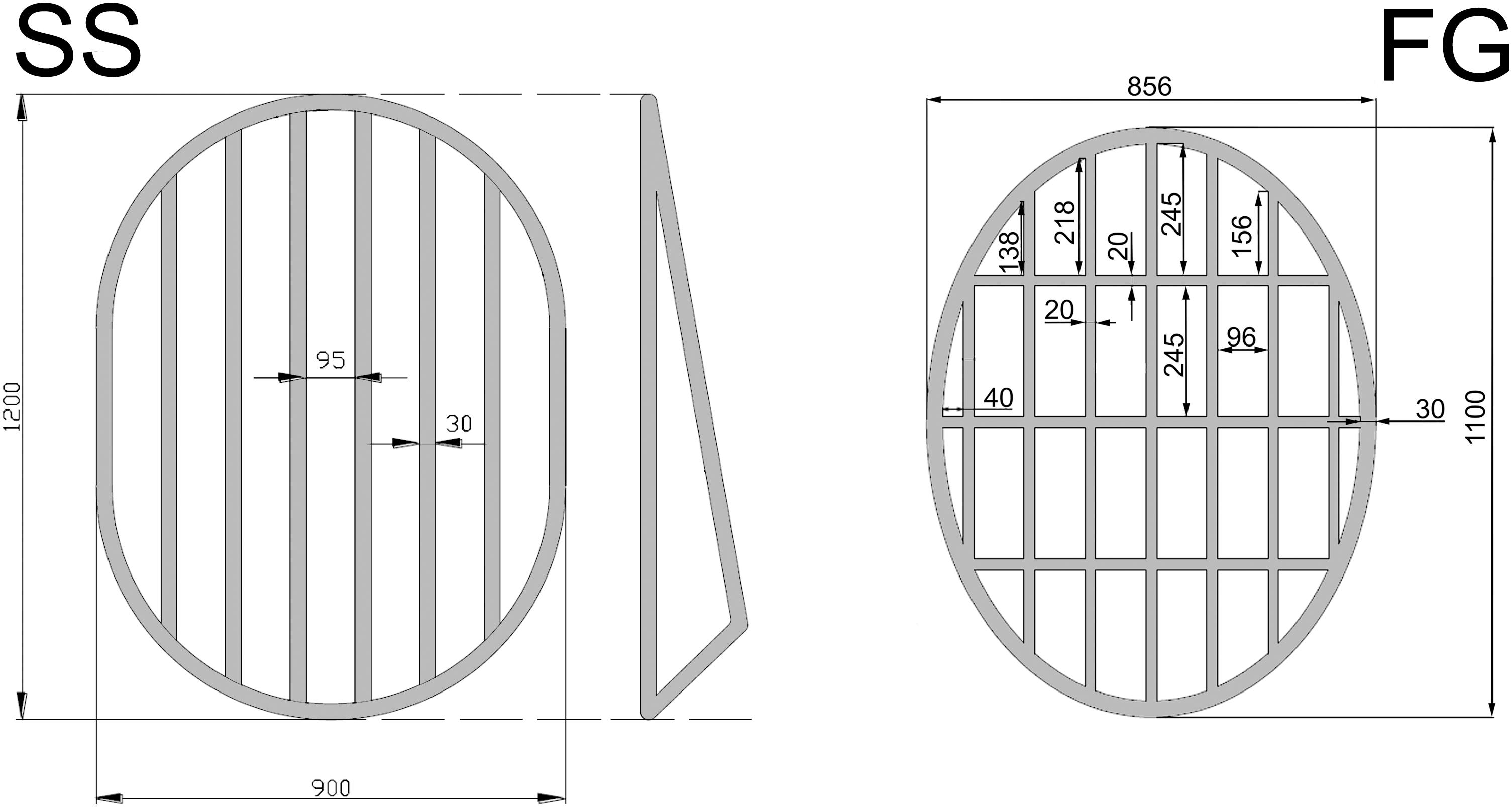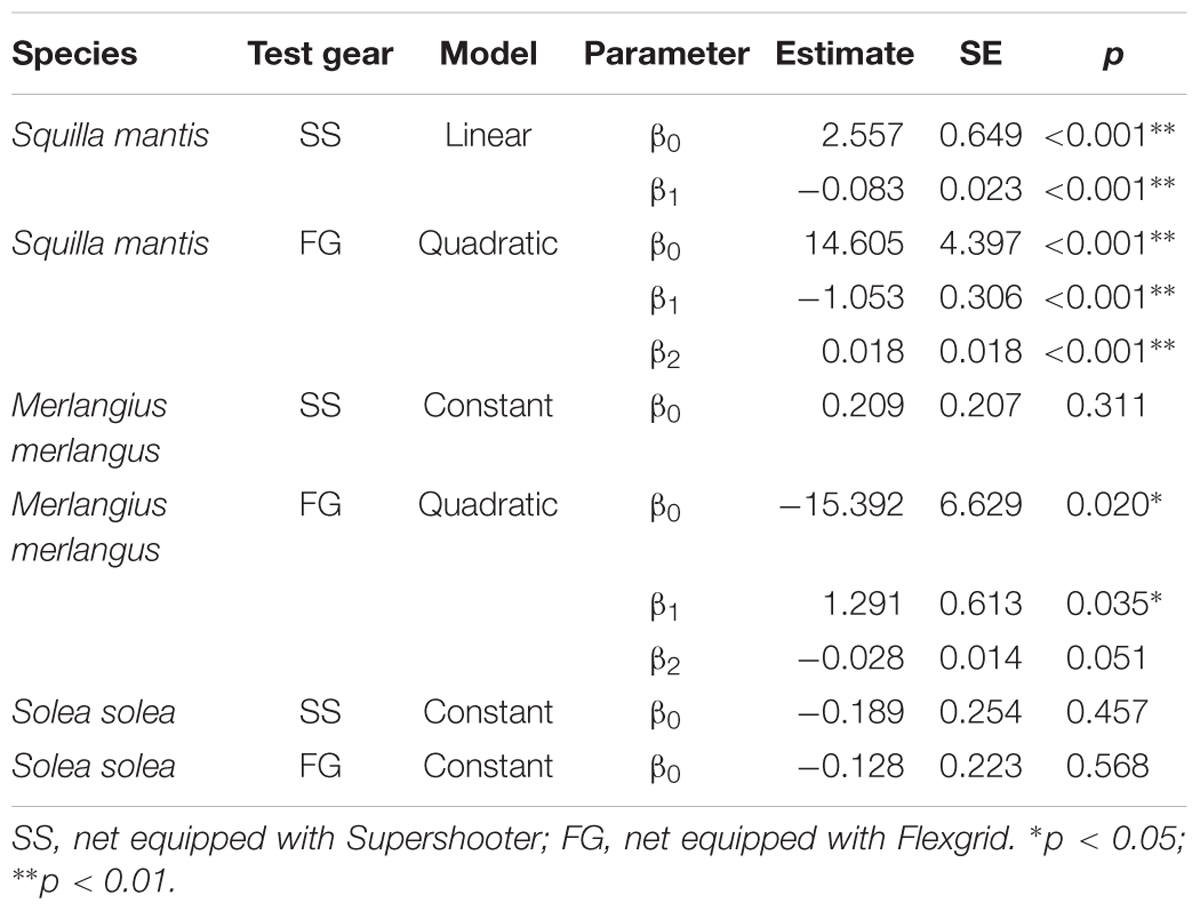- 1National Research Council (CNR), Institute of Biological Resources and Marine Biotechnology (IRBIM), Ancona, Italy
- 2Department of Biological, Geological, and Environmental Sciences, University of Bologna, Bologna, Italy
The sea turtle (Caretta caretta) is the most common sea turtle in the Mediterranean, where incidental catches due to fishing activities are considered the main threat to its conservation. Over 50,000 capture events and likely over 10,000 deaths are estimated to occur in the Italian waters alone. However, current knowledge on the interaction of sea turtles with fishing gears and the implementation of mitigation measures are still poor to hinder the decline of turtle populations in the Mediterranean. In this basin, where fisheries are multispecies, multi-gears and multinational, making demersal fishing activities profitable while preserving sea turtles is a challenge. This study aimed to develop bycatch reducer devices (BRDs) and alternative fishing gears to mitigate the impact of demersal fishing gears on sea turtles: (a) hard and flexible turtle excluder devices (TEDs) were tested in bottom trawling to immediately exclude turtles from the net; (b) visual deterrents (ultraviolet LEDs) were used to illuminate set nets and to alter turtle visual cues, avoiding entanglement during depredation activity. The results showed the different devices did not affect the commercial catch, while bycatch reduction was instead evident. Thus, the study highlights that introducing mitigation measures to reduce sea turtle bycatch in the Mediterranean, where the bycatch of vulnerable species seems as a global issue, can be possible at least in certain areas and periods. Considering fishermen reticence to change the gear traditionally used, determining the optimal gear configuration to minimize commercial loss while reducing bycatch, is the main issue while introducing new technologies. Therefore, a global effort should be done to introduce BRDs in different areas and fisheries of the Mediterranean.
Introduction
Fisheries in the Mediterranean basin include a wide variety of fishing activities and different gears operating mainly on small and medium scale. The intense fishing pressure is responsible of a general overexploitation status of fish resources (Colloca et al., 2017) and a growing degradation of marine habitats (Lotze et al., 2011). Large vertebrates like sharks (Ferretti et al., 2005), cetaceans (Bearzi et al., 2008), and sea turtles (Casale, 2011) are heavily affected by commercial fisheries, mainly because they are incidentally caught as bycatch. The loggerhead sea turtle (Caretta caretta) is the most common species of sea turtle in the Mediterranean, with densities estimated in summer of more than 0.046 individuals km-2 (Lauriano et al., 2011).
Caretta caretta is a protected species, included in the list of Annex IV of animals requiring close protection under the Habitat Directive and assessed by the International Union of Conservation of Nature and Natural Resources (IUCN) as “vulnerable” at global scale (Casale and Tucker, 2015) and as “least concern” for the Mediterranean Sea (Casale et al., 2015; Lucchetti et al., 2016b). Lucchetti et al. (2017a) estimated more than 52,000 bycatch events and 10,000 deaths occurring only in Italian waters in 2014, highlighting how fishing activities represent the main threat to the conservation of loggerheads (Lucchetti and Sala, 2010). Individuals frequenting shallow waters in order to feed on benthic species close to the bottom (Tomas et al., 2001; Hochscheid et al., 2013) often interact with fishing gears operating on the seabed (Lucchetti et al., 2016b).
Bottom trawl and set nets fishing are among the most widespread gears targeting demersal stocks, and responsible of high sea turtle bycatch rates in the Mediterranean (Casale, 2011). Bottom trawl is a fishing gear actively towed on the seabed, and turtles accidentally caught during trawling activities have a direct mortality depending on tow duration: the longer the tow duration, the greater the prolonged apnoea and mortality (Sasso and Epperly, 2006). The direct mortality induced by bottom trawling is around 18%. Moreover, delayed mortality due to drowning, metabolic disturbance, decompression sickness upon release (García-Párraga et al., 2014) is suspected to be high. In the North Adriatic Sea (GFCM Geographical Sub-Area 17), where over 1,000 trawlers operate annual turtle bycatch due to bottom trawling has been estimated in 8,600 individuals (Lucchetti et al., 2017a). Passive set nets are among the principal gears used in the small-scale fisheries; set nets targeting demersal fish are fixed on the bottom usually for about 12 h and passively catch fish. An accidentally entangled sea turtle is subjected to forced apnoea due to the long soaking time of the nets and consequent drowning. For the North Adriatic Sea, Lucchetti et al. (2017a) estimated more than 6,200 turtles caught in the west GSA 17 each year with the largest number in summer. The direct mortality caused by passive nets is much higher than bottom trawling and estimated at around 51%.
Possible solutions to avoid bycatch reside in new technological fishing gear improvements and adoption of devices, that may potentially help in reducing turtle entanglement or entrapment and, therefore, animal mortality rates (Casale et al., 2007; Lucchetti et al., 2016b). Recently in Mediterranean some bycatch reducer devices (BRDs) directed at mitigating the fishing impact on sea turtles have been tested. In bottom trawl fisheries, turtle excluder devices (TEDs) consisting in rounded sorting grids with bars (Epperly, 2003), placed before the codend to stop large objects or animals, thus expelling them by an exit, have been successfully experimented (Atabey and Taskavak, 2001; Sala et al., 2011; Lucchetti et al., 2016b). TEDs have become mandatory in several countries in prawn trawl fisheries due to their effectiveness (Lucchetti and Sala, 2010) and preliminary sea trials in the Mediterranean Sea showed good results especially in terms of fishing performance (no loss of commercial catch).
In the last years, the effect of a new prototype of TED, a flexible grid (Flexgrid), on the catching efficiency and performance of a commercial bottom trawl was tested in a gear comparison study for a Mediterranean coastal multispecies bottom trawl fishery (Lucchetti et al., 2016b). Findings demonstrated that this device did not affect neither bottom trawl technical performances (horizontal and vertical net opening and door spread) nor increased the required towing force, hence fuel consumption remained constant. Comparison of commercial catches for the major species showed that the use of this TED did not affect catching efficiency, while it reduced the amount of debris. The device did not influence the size of commercial species, leaving the selective performance of the trawl unmodified. Underwater video camera recordings documented that fish caught in the net swam through the grid and easily reached the cod-end, missing the TED escape opening. Easy storage and handling compared with previous devices tested in this area (Sala et al., 2011) make the flexible TED a practical and valuable solution to reduce turtle bycatch in coastal Mediterranean demersal multispecies fisheries.
In recent years, a potential bycatch reduction strategy for set nets fisheries has been connected to alteration of visual cues with lights. LED lamps and light sticks attached to gillnet float lines (Wang et al., 2010, 2013; Lucchetti et al., 2014; Ortiz et al., 2016; Virgili et al., 2018) have proven to be effective in decreasing turtle bycatch rates while preserving target species catch rates. The bycatch reduction observed ranged from 39.7 to 63.9% for Northern and Southern Pacific coasts by illuminating gillnets with green light (Wang et al., 2010; Ortiz et al., 2016) or UV light (Wang et al., 2013). For the Adriatic Sea (GSA 17), Virgili et al. (2018) observed a bycatch reduction of 100%, using UV light in bottom set-gillnet fisheries in deep waters (>70 m), while the efficiency of commercial catch was maintained.
Taken into account previous BRD tested in the Mediterranean Sea, the present study aims at:
(i) comparing the capture performances of a hard (Supershooter) and a flexible (Flexgrid) TED in bottom trawling;
(ii) assessing the efficacy of UV-LEDs to deter sea turtle bycatch in bottom gillnet fisheries set, to complete what has already been experimented by Virgili et al. (2018).
Materials and Methods
Study Area and Period
The study was carried out in the Northern Adriatic Sea, in sandy–muddy bottoms lying south of the Po river mouth (Figure 1, Central Mediterranean Sea). This area was selected because its shallow waters and rich benthic communities provide a major feeding habitat for turtles in the demersal stage, especially for the populations nesting in Greece (Lazar et al., 2004; Casale et al., 2012). Since the area is an important fishing ground, the risk of interaction with turtles is high: Lucchetti et al. (2017a,b) estimated more than 6,000 and 8,000 sea turtles are annually caught respectively by set and trawl nets in the North-Western Adriatic Sea, with a mortality rate of 15 and 24%, respectively. Winter time was chosen taking into account that previous studies (Lucchetti et al., 2017a) demonstrated sea turtles heavily interact with fishing gears in this period.
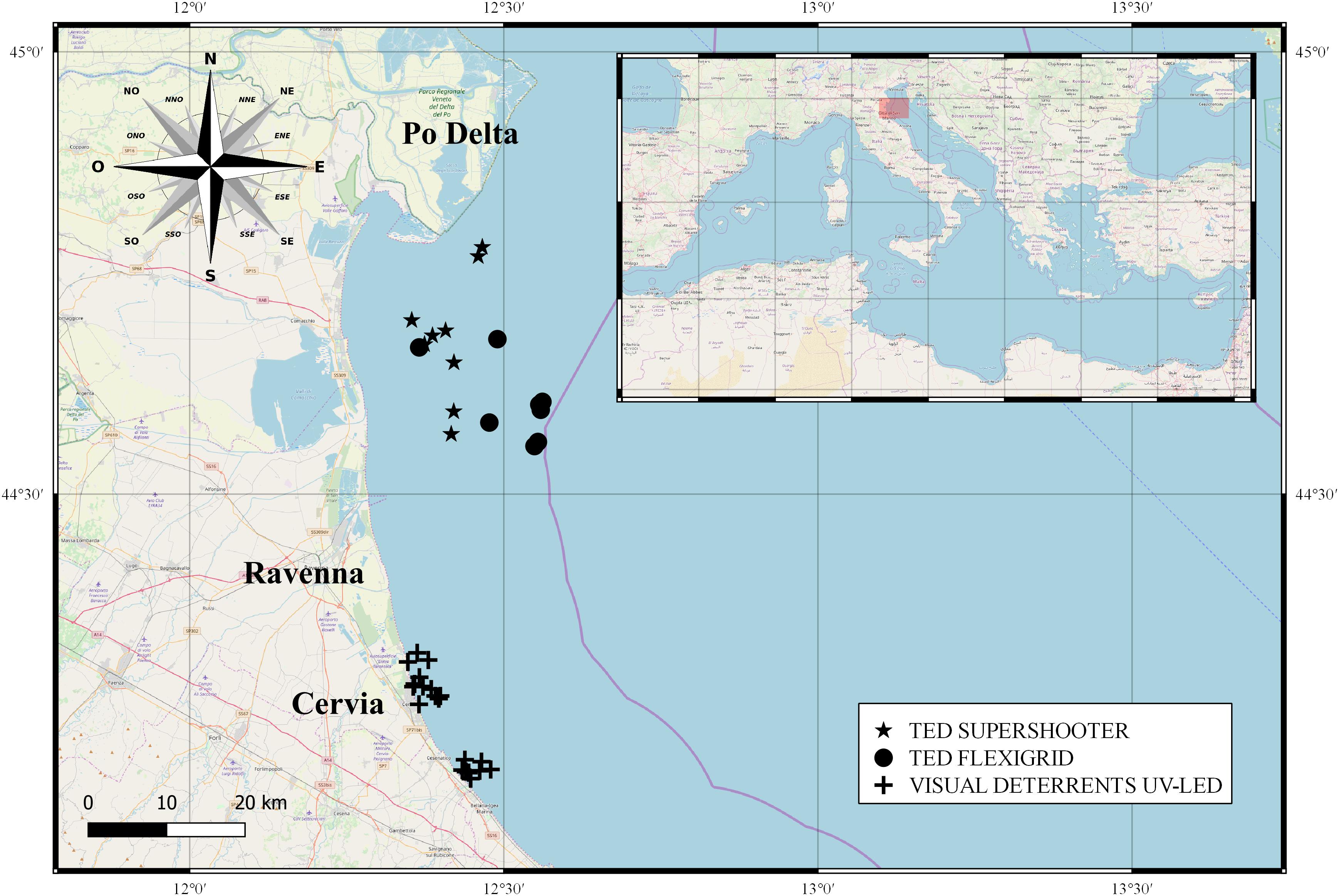
Figure 1. Map of sea trials carried out in North Adriatic Sea with BRDs: sorting grids (TEDs) in bottom trawling and visual deterrents (UV-LEDs) in set net.
Sea Trials and Gears
Bottom Trawl
Sea trials were conducted in December 2018 aboard a commercial fishing vessel from Porto Garibaldi (142 kW of engine power, 14.7 m length overall, and 12 GT of tonnage), in shallow waters (10–20 m deep) at distance of 5–10 nm off the coast (Figure 1). Twin trawl was used to compare directly the traditional trawl (Control) and the nets equipped with the TEDs. Each single net of the twin trawl was a typical “Americana” trawl, which is an asymmetric four-face trawl, generally used in this area to target crustaceans such as mantis shrimp (Squilla mantis) and caramote prawn (Penaeus kerathurus). This trawl is characterized by having two short bridles (∼10 m), high attack angles of the otterboards (40–45°; Lucchetti and Sala, 2012) and tickler chain to increase the fishing performance. A nominal 50 mm diamond mesh codend was mounted in each net [in compliance with the Regulation (Ec) 1967/2006, 2006].
Set Nets
A traditional bottom-set gillnet targeting common sole (Solea solea) and mantis shrimp was used for the study. The netting panels, made of transparent polyamide monofilament (diameter, 0.20 mm), were joined in the same gang for a total length of 1,200 m. Each panel was 100 m in length, 2.8 m in stretched net drop and the real vertical opening during fishing was around 1.6 m; the mesh opening was 74 mm. The headline was a 5 mm polypropylene rope with oval floats (15 × 20 mm) 4.6 m apart from each other. The leadline was a 4 mm polypropylene rope weighing 150 g/m. The hanging ratio, i.e., the slack of the netting panel (Lucchetti et al., 2015) was 0.36 and 0.38 for the float line and lead line, respectively.
Experimental trials were conducted on board a fishing vessel (14.7 kW, 6.1 m overall length, 2 gross tonnage) employing gillnets throughout the year in coastal waters (3–5 nm off coast) at a depth of 8–15 m.
BRDs Specifications
Hard and Flexible TEDs
Two different types of TEDs were designed according to the technical specifications suggested by (Mitchell et al., 1995), manufactured and tested at sea. The tested TEDs differed in their material and shape, and were similar for size and bar spacing. The hard TED was a classic aluminum Supershooter grid (Figure 2), commonly used in shrimp fisheries in several countries. By considering the complex Adriatic fishing composition (crustaceans, molluscs, and fishes caught together), we kept the space between reflector bars greater than in standard models. The Supershooter had the following features: height: 1,200 mm; width: 900 mm; bar diameter: 30 mm; spacing between bars: 95 mm.
The flexible TED (Flexgrid – Comet trawl, Denmark), made of an alloy of high strength plastic material, allowed to maintain a stiff configuration during trawling and to ride on the net drum as the net was recovered. The flexible TED dimensions were: height: 1,130 mm; width: 845 mm; circumference: 3,110 mm; bar diameter: 20 mm; spacing between bars: 96 mm.
Both grids were mounted on a tubular netting section (6 m in length) and placed immediately in front of the codend. An escape opening was cut on the lower portion of the net just before the TED and covered by a netting panel with three sides sewn to the net to prevent loss of commercial species. The fourth side was free and functioned as a valve, as it opened only when it was hit by large and heavy objects, and thus allowing sea turtles and other bycatch species to out the net. In both the TEDs tested, TED angle was set to 45–48°, which is an important factor in preventing commercial losses during the tow (Mitchell et al., 1995; Eayrs, 2007). In fact, an angle less than 40° may involve catch loss due to water diversion through the exit hole. Angles greater than 55° can prevent turtle escape and deflection of trash, clogging the grid.
The use of a twin trawl was the ideal solution to compare directly the catch performance of TED and the traditional net; the net with TED installed was considered as the TEST net, the net without TED was the Control (CTRL) net.
Visual Deterrents
The low water transparency characterizing the study area, which is affected by massive river inputs (Ludwig et al., 2009), prompted the use of UV-LED lamps (Electralume, Lindgren-Pitman, United States). UV-LED lamps perform better than common light sticks, because they provide consistent high-intensity illumination, they last longer, and their light penetrates deeper into the water compared with chemical light sticks. Each lamp is fitted with two batteries that provide approximately 30 days of function. The intensity of the light was checked before each trial and low batteries were replaced as necessary.
The optimal distance between the lamps was established in preliminary tests based on the studies carried out by Wang et al. (2013) and Ortiz et al. (2016), who suggested a distance between lamps of 5 and 10 m, respectively. The negative lamps buoyancy (around 108.6 g each with the batteries) and the low net height required a visual check, to assess that lamp’s weight did not reduce the headline floatability, thus impairing fishing performance. Underwater video recordings have shown that setting the distance between UV-LED lamps ≤10 m, as suggested by Wang et al. (2013) and Ortiz et al. (2016), would involve an excessive weight on the float line, with a partial closure of the net and a reduction of the fishing surface. Therefore, a distance ∼15 m (corresponding to 70 lamps/km) was found to maximize gear performance and illumination as described in Virgili et al. (2018).
Data Analysis
Bottom Trawl
For each haul, the catch was divided into four categories: Commercial species (fish retained and sold), Discards (e.g., fish without commercial value, below the minimum legal size, damaged, skinned, etc.), and debris, which included anthropogenic material (marine litter) and natural material (shells, wood, stones, etc.), PET (Protected, Endangered and Threatened species, including C. caretta).
Catches were standardized as:
where CPUEW is the catch per unit effort expressed in terms of weight (Kg) per hour of trawling, W is the weight of the catch of each single haul and the Tow Duration is the time the net fished in each single haul expressed in minutes. A One Way ANOVA was applied to compare the commercial, discards and debris CPUEW among TEDs and control net.
For commercial species, the total length for fish (TL) and the carapace length for crustaceans (CL) were measured on-board the vessels to the nearest 0.5 cm below. To assess the influence of the TED on the size of the species caught, the length frequency distributions (LFD) for the commercial species representing more than 5% of the total catch in weight were analyzed. The generalized linear mixed model – GLMM (with haul as random intercept) was successfully used to fit curves for the expected proportions of the total catch and thus to assess the catch efficiency (at length) of TED relative to CTRL, as suggested by Holst and Revill (2009). The probability of a fish being retained by TED follows from:
A binomial error distribution was used to calculate the probability of the number of fish caught in the TED gear given they enter both gears by 1-cm size class (1-mm for crustaceans). A probability of 0.5 corresponds to equal catches in both gears. The analyses proceeded as recommended by Holst and Revill (2009), by fitting third order polynomials followed by subsequent reductions until all terms showed significance; this would be adequate for most cases, although in some instances a first or second order would be enough. As suggested by Holst and Revill (2009), the best model is the minimal degree polynomial curve that captures the main trends indicated by the observed proportions. The best model describing the retention probability was decided based on the lowest value of AIC. The species selected correspond to the most important commercial species during the study period: S. mantis, Merlangius merlangus, and S. solea.
Fishing hauls were performed following the fishermen decisions dealing with target species, fishing grounds, tow duration, etc., in order to operate in a commercial situation. According to the fishing practices the Supershooter was used in shallower waters (16 m of depth) than Flexgrid (26 m of depth). Taking into consideration the different fishing grounds, the statistical analysis enabled to directly compare the control net used in coastal waters (TC) against the Supershooter (SS), and the control net used in deeper waters (TO) against the Flexgrid (FG).
All the analyses were performed using the free software R (R Core Team, 2016) and the R packages nlme (Pinheiro et al., 2018) and lme4 (Bates et al., 2015).
The sea turtles eventually caught (as well as other bycatch species) were measured (curved carapace length, CCL, in cm) and weighed, and then rescued as laid down by Italian Ministry of Environment guidelines (Mo et al., 2013).
Set Nets
In each trial, netting panels fitted with UV-LED lamps (Test nets) were compared with panels without illumination (Control nets). The netting panels with and without the lamps were randomly distributed along the gang, to avoid introducing additional variables. An escape area of about 15 m was left between illuminated and non-illuminated panels, to maximize their separation. The nets were set at sunset and retrieved at sunrise, providing for an average soak time of 10–16 h.
After the net was hauled on board, the catch of the Test and Control nets was analyzed separately. The catch was sorted into commercial species, discards and PET (including species as C. caretta, Pteroplatytrygon violacea, Myliobatis aquila, Dasyatis pastinaca, Prionace glauca, Carcharhinus plumbeus). Commercial, discard, and PET species were classified to the lowest possible taxonomic level, and their number and weight standardized as number and weight per 1000 m of net and 12 h of soak time, as follows:
where CPUEN is the catch per unit effort expressed as number of individuals and CPUEW is the catch per unit effort in terms of weight (kg); Nc and Wc are respectively the number and weight of captured individuals.
For commercial species, the total length (TL) of each specimen was measured to the nearest 0.5 cm below. Any sea turtles found in the nets were disentangled after recording their position in the gillnet, measured (curved carapace length, CCL, in cm), weighed, and rescued as above described. Those in good physical condition were released after a period of rest on board (>2 h). The CPUEs of the different categories found in the Test and Control nets were analyzed using the One Way ANOVA.
Length-frequency distributions (LFD) were analyzed for the target species (S. solea). The catch-comparison analysis described for TED vs. Traditional trawl (above described) was applied to assess the influence of LED on the size of common sole caught. The polynomial regression GLMM (with haul as random intercept) was successfully used to fit curves for the expected proportions of the total catch and thus to assess the catch efficiency (at length) of LED relative to CTRL. The probability of a fish being retained by LED follows from:
A probability of 0.5 means no difference between the gears.
Results
TEDs in Bottom Trawling
The general details of each haul and the mean catch per gear, categories and species are summarized in the Supplementary Annex SI. The two TEDs performed in accordance with their objectives: on average, comparing TC vs. SS and TO vs. FG the discards were reduced and the debris (anthropic litter, shells, stones, etc.) was usually excluded by the escaping window (Figure 3 and Table 1). However, in some hauls both discards and debris showed a great variability, so that the standard deviation was high and the differences were not statistically significant except for the debris excluded by the Supershooter and the discards reduced by the Flexgrid (Table 1). The results showed that both TEDs can be used in commercial conditions without negatively affect the commercial catch (Table 1).
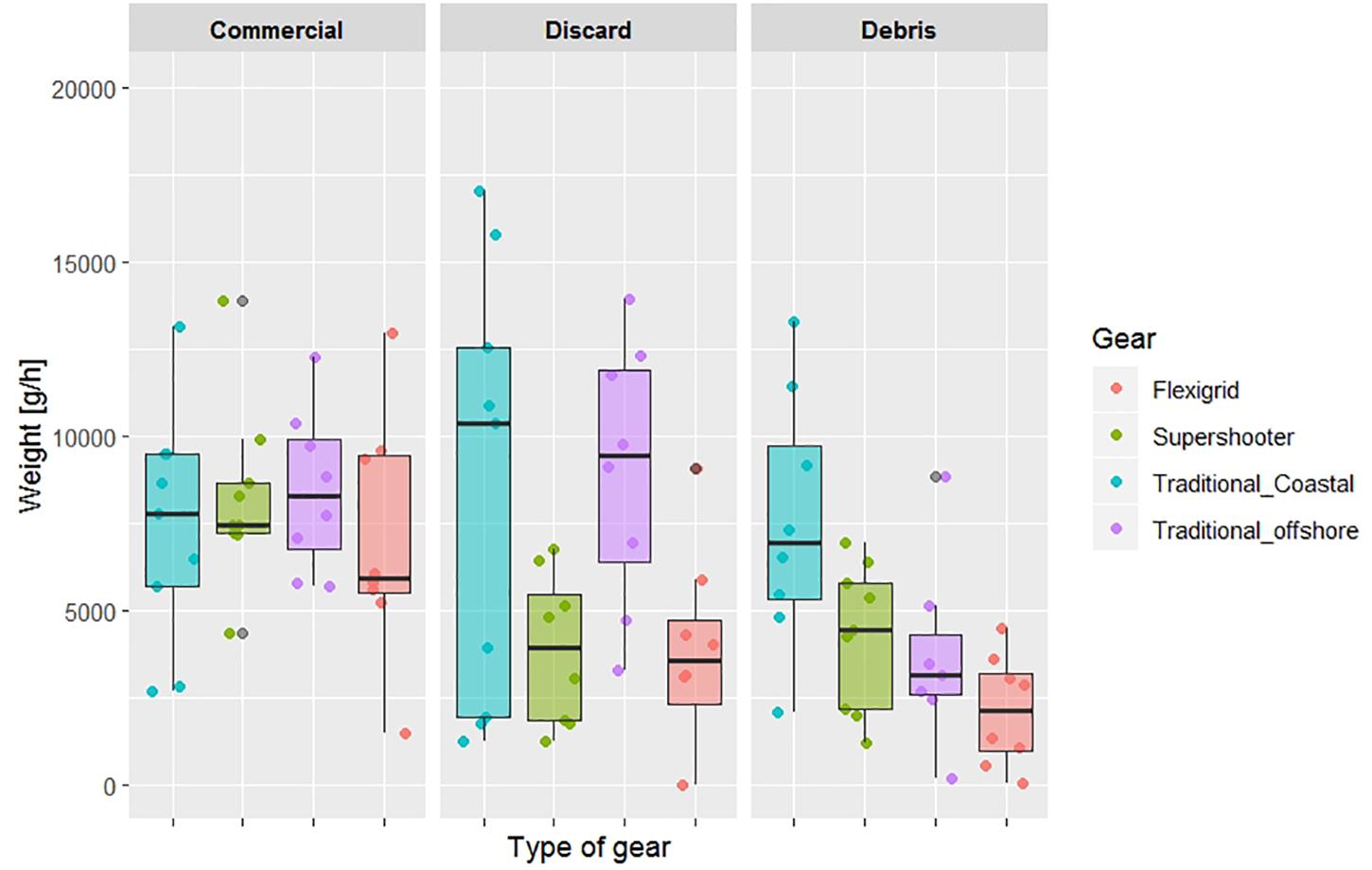
Figure 3. Box plot of the mean catches (g ⋅ h-1) and standard deviations of the different categories (Commercial, Debris, and Discards) obtained with the different tested nets.
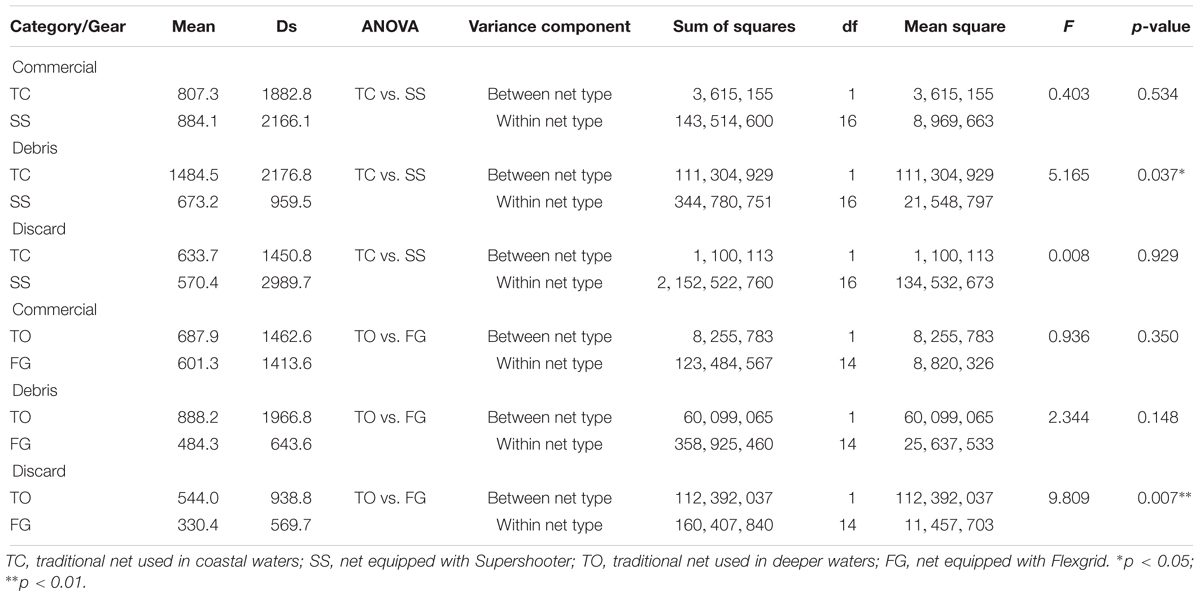
Table 1. Standardized catch (g ⋅ h-1) and summary of the One-way ANOVA applied to categories: Commercial, debris, and discard to assess the difference between two types of nets (with and without TED).
Constant, Linear, and quadratic models fit catch comparisons for different species (Table 2), however, in general, the catch-comparison analysis showed a similar catch performance of TEDs and control nets, because the ratio TED/(TED + CTRL) is almost near the value 0.5 indicating that both nets caught similar number of fishes (Figure 4). From the species listed in Supplementary Annex SII it is clear there were no differences in the species composition.
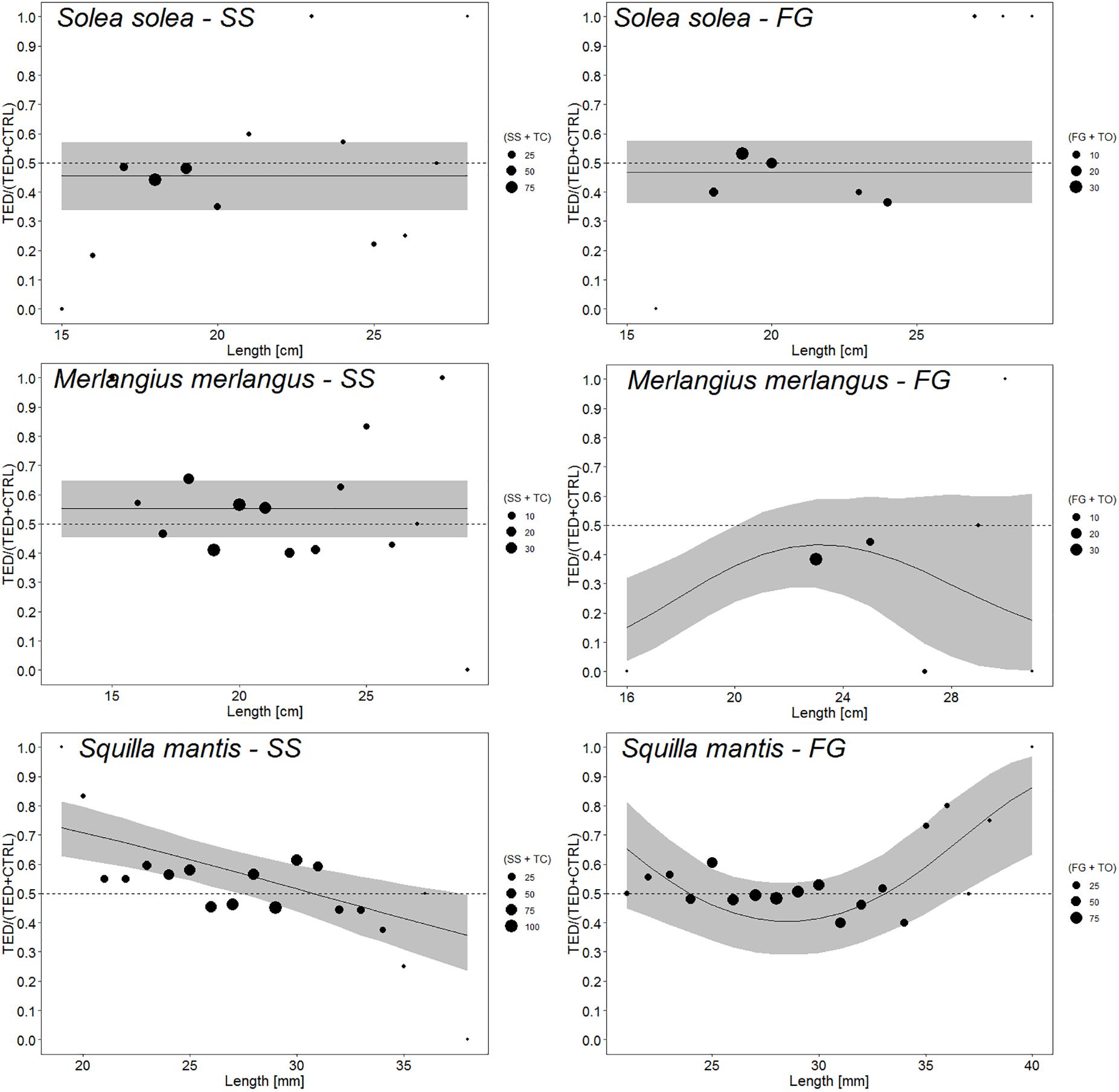
Figure 4. GLMM modeled proportions of the total catches caught by the TEDs. Interpretation: a value of 0.5 indicates an even split between TED and CTRL, whereas a value of 0.25 indicates that the net mounting TED caught 25% of the total fish at that length and 75% were caught in the CTRL net. Shaded area is the 95% confident interval. The size of dots refer to the sum (TED + CTRL) of specimens for each length class.
During nine hauls performed in coastal waters to assess the performance of Supershooter TED, 10 sea turtles were caught in the control net only. These were juveniles and sub-adults with a carapace length ranging from 33 to 82 cm see Supplementary Figures S3, S4. No turtles were observed in the catch of sea trials performed at deeper depth.
UV LEDs in Set Nets
A total of 20 sets (Test and Control nets) were carried out during June and November 2018. Total net length ranged from 1.2 to 1.8 km (mean 1.53 ± 0.3 km; hereafter mean ± standard error, SE). The mean length of the net portions without and with illumination was 0.76 ± 0.15 km. Mean soak time was 12 ± 1.6 h and mean fishing depth was about 8–10 m.
The mean CPUEN of the three catch fractions (commercial, discard, and bycatch) neither mean CPUEW were not significantly different between Control and Test nets (Table 3). Further analysis of the catch of the target species showed that the CPUE was highest for the two target species, S. solea and S. mantis (Table 3), which accounted respectively for 28 and 20% of the catch in terms of number of individuals and for 17 and 9% in terms of weight. Also in this case, the mean CPUEs for the two target species were not significantly different between the nets.
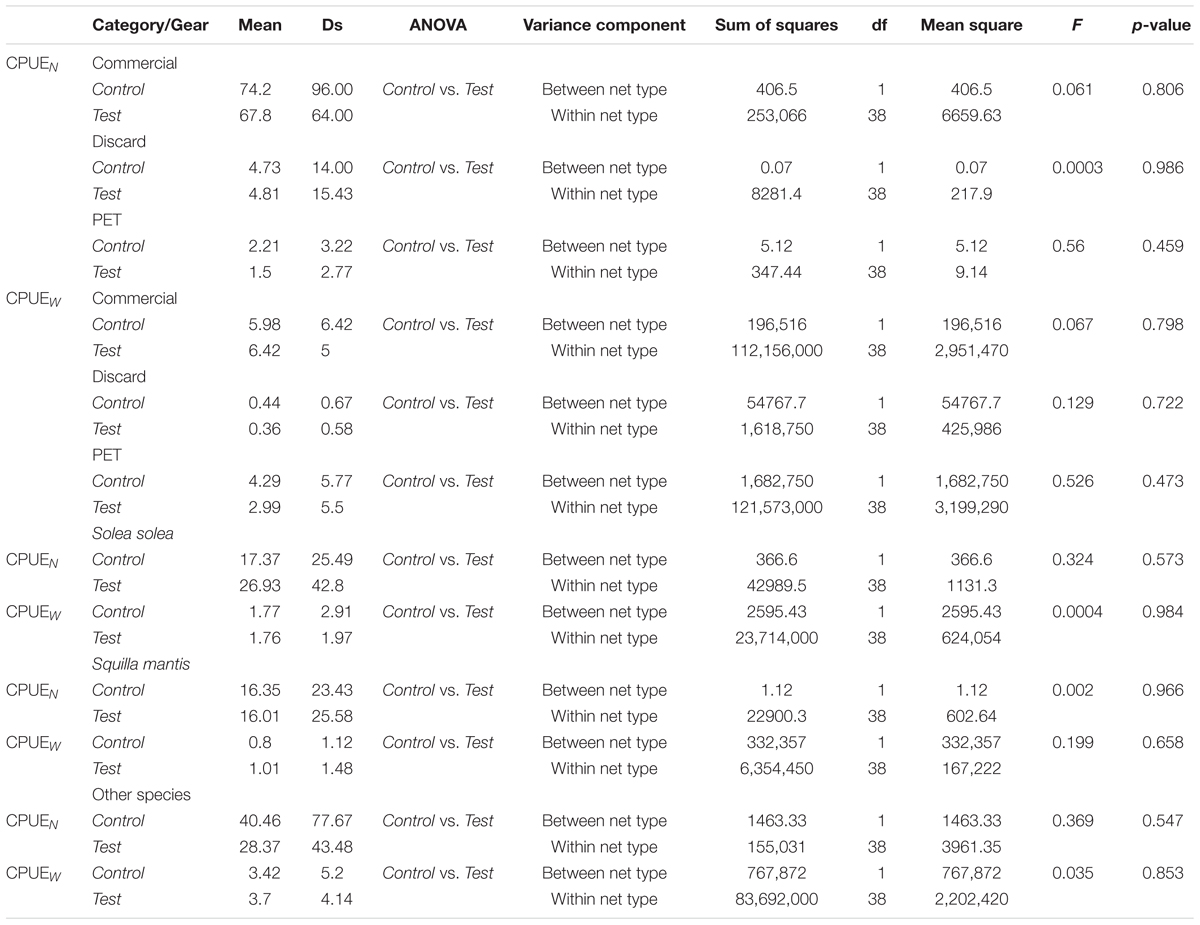
Table 3. Set net catch rates expressed as mean CPUEN and CPUEW and summary of the One-way ANOVA applied to categories: Commercial, discard, PET (Protected, Endangered, and Threatened species), and target species to assess the difference between two types of nets (with and without LEDs; Control = without illumination; Test = with UV-LED lamps).
Two loggerheads were caught during the study period (see Supplementary Figures S1, S2), both were released in good condition after a period of rest on board. Individuals were juveniles and subadults; their CCL was 23 and 40 cm and weight were 1.4 and 8 kg, respectively. Turtles were caught by the Control nets. The mean CPUEN was 0.14 ± 0.10 and the mean CPUEW was 0.57 ± 0.45 kg.
Catch-comparison analysis highlights there were no differences by size in the catch performance of net equipped with LEDs and nets in the control configuration; the ratio LED/(LED+CTRL) is almost near the value 0.5 (Intercept: 0.499; Figure 5) and a constant model fits the catch comparison for this species (parameter β0 = -0.065 ± 0.267). The list of species reported in the Supplementary Annex SIII clearly demonstrates there were no appreciable differences in the species composition.
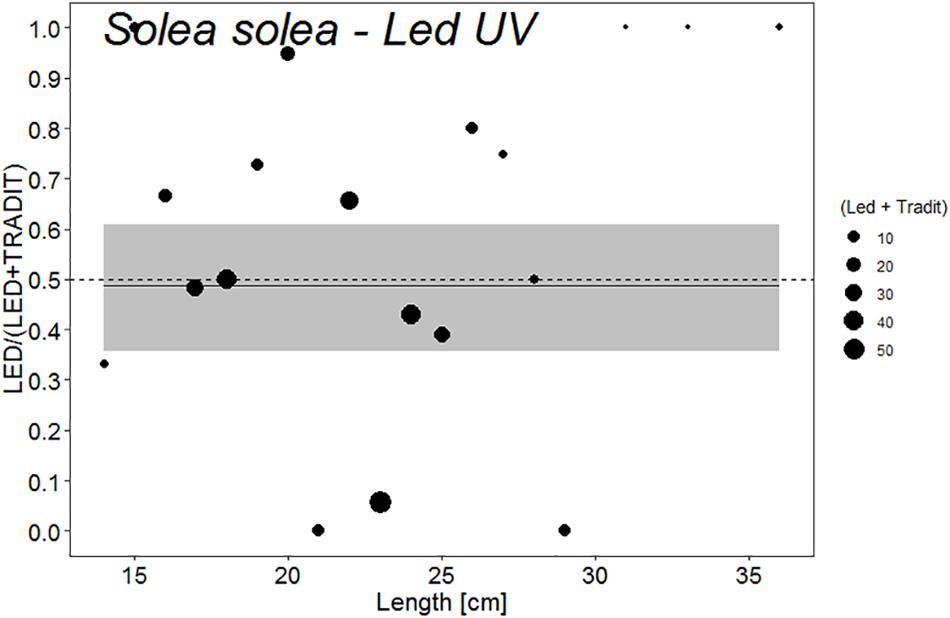
Figure 5. GLMM modeled proportions of the total catches caught by the net equipped with LED. Interpretation: a value of 0.5 indicates an even split between LED and CTRL net. Shaded area is the 95% confident interval. The size of dots refer to the sum (LED + CTRL) of specimens for each length class.
Discussion
Given the fishermen’s reluctance to change their traditional gear, a key aim of this study was to determine the optimal BRDs configuration that would minimize both the loss of commercial catch and turtle captures. In the present study, we compared the performance of a rigid Supershooter TED and a flexible TED (Flexgrid) in the Mediterranean bottom twin-trawling. In more detail, we assessed the performances in terms of possible commercial losses and reduction of bycatch, discards, and debris.
Turtle excluder devices are usually designed to reduce sea turtle bycatch but, in the current study, we verified they also reduce the accumulation of debris on the codend, which negatively affects the fish quality by damaging and spoiling fish, crushing crustaceans, etc. Moreover, the presence of a turtle in the codend catch can crush the fish already caught compromising the quality of the catch. In particular, the Supershooter successfully operates by expelling sea turtles from the net and reducing the debris. Innovations of fishing gears can be easily accepted by professional fishermen only if the economic losses are negligible and if the new gears or devices do not involve changes to the on-board procedures. The results show that both tested TEDs reduce debris and discards while keeping the commercial part of the catch unchanged. Discards reduction was statistically significant in the Flexgrid; this is of paramount importance on the light of European Regulation (Ec) 1380/2013 (2013), that introduced a legal framework for discards reduction in the Mediterranean. Present findings confirm the results obtained in the Mediterranean in other studies with Supershooter (Sala et al., 2011) and Flexgrid (Lucchetti et al., 2016b). Atabey and Taskavak (2001) found promising results in the Turkish fishery because their modified Supershooter excluded both loggerhead and green sea turtles (Chelonia mydas), as well as unwanted incidental catches such as jellyfish, sharks, and rays.
The selective performance of the net was unchanged with the addition of the TEDs. In fact, there was not any appreciable difference in the size frequency distributions of the fish caught nor in the species composition. Even if with slight differences, the catch-comparison analysis showed that the ratio TED/(TED + CTRL) was almost near the value 0.5, indicating that both nets (control net and net with TED) caught similar number of fishes. The results clearly show that the TEDs designed and tested in the current study can be successfully used in coastal trawling, where the most important commercial species have small sizes. Furthermore, the use of TED would lead to a reduction in debris in the codend in an area (the north-western Adriatic) where the amount of anthropic and natural waste is high due to the massive influx of the Po river (Strafella et al., 2015). Therefore, both TEDs were effective but some logistic and technical aspects could be taken into consideration in choosing the best TED: the Flexgrid was sufficiently stiff to maintain a rigid configuration during towing, and sufficiently flexible for safe winding around a standard net winch. Therefore, it did not require changes to on board procedures and did not induce a loss of time for fishermen during hauling. The Supershooter is made of aluminum and its rigidity would imply a slight change in the procedures on board. On the other hand, two horizontal bars are required in the Flexgrid to maintain the rigidity of the grid during towing; this reduces the space to allow the fish to pass toward the codend compared to the Supershooter.
Sea turtle migrations are strongly linked with sea water temperature and prey availability (Casale et al., 2018). As a possible result of climate changes, the present study confirms that sea turtles winter in the shallow waters of the Adriatic Sea where temperatures fall below 13°C, thus remaining at northern latitudes rather than migrating south and aggregate in small groups, as reviewed by Luschi and Casale (2014) and in accordance with Hochscheid et al. (2007). This is alarming: although sea turtles may adapt to the increasing temperatures, climatic changes in foraging and overwintering habitats will probably negatively affect loggerhead turtle populations nesting in the eastern Mediterranean Basin (Patel et al., 2016). Taking into account the fact that the turtles were only caught in very coastal waters, near mussel farms, these animals are likely to find easy availability of prey near the aquaculture facilities. Lucchetti et al. (2016a) identified the study area as a possible hot spot for bottom trawl-sea turtle interaction, especially at depths shallower than 40 m. In this area, the TEDs tested in the present study were highly efficient. Therefore, the adoption of TED in critical areas and seasons together with other management measures has the potential to provide a substantial contribution to the conservation of C. caretta in the whole Mediterranean.
No practical solution to reduce the risk of bycatch due to set nets was available for Mediterranean fisheries until a few years ago, except reducing netting twine thickness or using gillnets instead of trammel nets. The UV-LED lamps tested in the current study did not affect the catch efficiency of the major commercial species. Interestingly, however, they did reduce the interaction with sea turtles, since no loggerheads were found in the illuminated portions of the net. Virgili et al. (2018), tested for the first time this BRDs applied to gillnets targeting rays in the Adriatic Sea (offshore waters), in an area that has been proven to be a hotspot of sea turtle occurrence (Lucchetti et al., 2017b). The net was illuminated with the same UV-LED lamps used in the present study, which have a longer life and provide greater light intensity than ordinary light-sticks. They obtained the same results, with sea turtle bycatch zeroing and no differences in the commercial catch. Visual deterrents, like chemical light sticks and LED lamps mounted on set nets, have successfully been tested in gillnet fisheries in some areas of the Pacific Ocean, where they have proved effective in reducing the sea turtle bycatch (Wang et al., 2010, 2013; Ortiz et al., 2016). Although further sea trials are needed, UV-LED illumination confirms to be an effective tool to deter sea turtles from approaching set nets in Mediterranean while preserving the commercial catch.
This was a pilot study trying to test the efficacy of TED (in bottom trawl) and lamps (in passive nets) to reduce sea turtle bycatch while keeping unchanged the commercial catch. The study does not claim to be exhaustive and definitive of the problem; however, the results are encouraging and the use of these devices can be replicated efficiently in the main Mediterranean demersal fishing activities that operate with bottom trawls and passive nets. Therefore, before introducing these BRDs in the fisheries mentioned above, it is appropriate to carry out a final distribution of these devices to a reasonable number of vessels.
Data Availability
The raw data supporting the conclusions of this manuscript will be made available by the authors, without undue reservation, to any qualified researcher.
Ethics Statement
Caretta caretta is a protected species, included in the list of Annex IV of animals requiring close protection under the Habitat Directive and assessed by the International Union of Conservation of Nature and Natural Resources (IUCN) as “vulnerable” at global scale (Casale and Tucker, 2015) and as “least concern” for the Mediterranean Sea (Casale et al., 2015; Lucchetti et al., 2016b). In this study, no manipulations were performed on the turtles and no direct interventions were carried out. We only recorded individual capture events. In case of injured turtles observed in the catch, the procedures of the Italian Ministry of Environment guidelines were applied (“Linee Guida per il recupero, soccorso, affidamento e gestione delle tartarughe marine ai fini della riabilitazione e per la manipolazione a scopi scientifici,” Mo et al., 2013) and sea turtles were rescued by Authorized Rescue Centres. All applicable international, national, and/or institutional guidelines for the care and use of animals were followed, in particular: Mo et al. (2013). This article does not contain any studies with human participants performed by any of the authors.
Author Contributions
AL made the analysis and wrote the manuscript. MV, GB, AP, and CV made the data collection. MV wrote some parts of the manuscript. GB, AP, and CV reviewed the manuscript.
Funding
This work was conducted with the contribution of the LIFE Financial Instrument of the European Community, TartaLife Project – Reduction of sea turtle mortality in professional fishing (LIFE12NAT/IT/000937).
Conflict of Interest Statement
The authors declare that the research was conducted in the absence of any commercial or financial relationships that could be construed as a potential conflict of interest.
Acknowledgments
This research study was authorized by the Italian Coast Guard. It does not necessarily reflect the European Commission’s views and in no way anticipates future policy. This support is gratefully acknowledged. We are indebted to the personnel of CNR-IRBIM (Ancona) and CESTHA (Marina di Ravenna), to the crew of FVs Kairos and Stella Maris for their help in fieldwork.
Supplementary Material
The Supplementary Material for this article can be found online at: https://www.frontiersin.org/articles/10.3389/fmars.2019.00387/full#supplementary-material
FIGURE S1 | See turtle disentangled from the gillnet during hauling procedures.
FIGURE S2 | See turtle caught in the gillnet tests.
FIGURE S3 | See turtle caught and released by the TED during trawl tests (1).
FIGURE S4 | See turtle caught and released by the TED during trawl tests (2).
ANNEX SI | Details of the hauls performed during the study. TC: Traditional net used in coastal waters; SS: net equipped with Supershooter; TO: Traditional net used in deeper waters; FG: net equipped with Flexgrid.
ANNEX SII | Details of the mean catch and standard deviation (g/h) by categories and gears obtained during the study. TC: Traditional net used in coastal waters; SS: net equipped with Supershooter; TO: Traditional net used in deeper waters; FG: net equipped with Flexgrid.
ANNEX SIII | Details of the mean catch and standard deviation (g/12h∗1000m) by categories and gears obtained during the study. CTRL: Traditional net used and UV-LED: set net equipped with visual deterrents.
References
Atabey, S., and Taskavak, E. (2001). A preliminary study on the prawn trawls excluding sea turtles. J. Fish. Aquat. Sci. 18, 71–79.
Bates, D., Martin, M., Bolker, B., and Walker, S. (2015). Fitting linear mixed-effects models using lme4. J. Stat. Softw. 67, 1–48.
Bearzi, G., Agazzi, S., Gonzalvo, J., Costa, M., Bonizzoni, S., Politi, E., et al. (2008). Overfishing and the disappearance of short-beaked common dolphins from western Greece. Endanger. Species Res. 5, 1–12. doi: 10.3354/esr00103
Casale, P. (2011). Sea turtle by-catch in the Mediterranean. Fish Fish. 12, 299–316. doi: 10.1111/j.1467-2979.2010.00394.x
Casale, P., Affronte, M., Scaravelli, D., Lazar, B., Vallini, C., and Luschi, P. (2012). Foraging grounds, movement patterns and habitat connectivity of juvenile loggerhead turtles (Caretta caretta) tracked from the Adriatic Sea. Mar. Biol. 159, 1527–1535. doi: 10.1007/s00227-012-1937-2
Casale, P., Broderick, A. C., Camiñas, J. A., Cardona, L., Carreras, C., Demetropoulos, A., et al. (2018). Mediterranean Sea turtles: current knowledge and priorities for conservation and research. End. Species Res. 36, 229–267. doi: 10.3354/esr00901
Casale, P., Cattarino, L., Freggi, D., Rocco, M., and Argano, R. (2007). Incidental catch of marine turtles by Italian trawlers and longliners in the Central Mediterranean. Aquat. Conserv. Mar. Freshw. Ecosyst. 17, 686–701. doi: 10.1002/aqc
Casale, P., Freggi, D., Furii, G., Vallini, C., Salvemini, P., Deflorio, M., et al. (2015). Annual survival probabilities of juvenile loggerhead sea turtles indicate high anthropogenic impact on Mediterranean populations. Aquat. Conserv. Mar. Freshw. Ecosyst. 25, 551–561. doi: 10.1002/aqc.2467
Casale, P., and Tucker, A. D. (2015). Caretta caretta. IUCN Red List Threat. Species 2015:20. doi: 10.2305/IUCN.UK.2015-4.RLTS.T3897A83157651.en
Colloca, F., Scarcella, G., and Libralato, S. (2017). Recent trends and impacts of fisheries exploitation on mediterranean stocks and ecosystems. Front. Mar. Sci. 4:244. doi: 10.3389/fmars.2017.00244
Epperly, S. P. (2003). “Fisheries-related mortality and turtle excluder devices (TEDs),” in The Biology of Sea Turtles, eds P. L. Lutz and J. A. Musick (Boca Raton, FL: CRC Press, Inc), 339–353. doi: 10.1201/9781420040807.ch13
European Regulation (Ec) 1380/2013 (2013). Regulation (EU) No 1380/2013 of 11 December 2013 on the Common Fisheries Policy, Amending Council Regulations (EC) No 1954/2003 and (EC) No 1224/2009 and Repealing Council Regulations (EC) No 2371/2002 and (EC) No 639/2004 and Council Decision 2004/585/EC. Brussels: European union.
Ferretti, F., Meyers, R. A., Sartor, P., and Serena, F. (2005). “Long term dynamics of chondrichthyan fish community in the upper Tyrrhenian Sea. ICES CM 2005/N:25,” in Proceedings of the 2005 ICES Annual Science Conference on Theme Session on Elasmobranch Fisheries Science, (Copenhagen: ICES), 1–34.
García-Párraga, D., Crespo-Picazo, J. L., De Quirós, Y. B., Cervera, V., Martí-Bonmati, L., Díaz-Delgado, J., et al. (2014). Decompression sickness (’the bends’) in sea turtles. Dis. Aquat. Organ. 111, 191–205. doi: 10.3354/dao02790
Hochscheid, S., Bentivegna, F., Bradai, M. N., and Hays, G. C. (2007). Overwintering behaviour in sea turtles: dormancy is optional. Mar. Ecol. Prog. Ser. 340, 287–298. doi: 10.3354/meps340287
Hochscheid, S., Travaglini, A., Maffucci, F., Hays, G. C., and Bentivegna, F. (2013). Since turtles cannot talk: what beak movement sensors can tell us about the feeding ecology of neritic loggerhead turtles. Caretta caretta. Mar. Ecol. 34, 321–333. doi: 10.1111/maec.12018
Holst, R., and Revill, A. (2009). A simple statistical method for catch comparison studies. Fish. Res. 95, 254–259. doi: 10.1016/j.fishres.2008.09.027
Lauriano, G., Panigada, S., Casale, P., Pierantonio, N., and Donovan, G. P. (2011). Aerial survey abundance estimates of the loggerhead sea turtle Caretta caretta in the Pelagos Sanctuary, northwestern Mediterranean Sea. Mar. Ecol. Prog. Ser. 437, 291–302. doi: 10.3354/meps09261
Lazar, B., Margaritoulis, D., and Tvrtkovic, N. (2004). Tag recoveries of the loggerhead sea turtle Caretta caretta in the eastern Adriatic Sea: implications for conservation. J. Mar. Biol. Assoc. 84, 475–480. doi: 10.1017/S0025315404009488h
Lotze, H. K., Coll, M., and Dunne, J. A. (2011). Historical changes in marine resources, food-web structure and ecosystem functioning in the adriatic Sea, Mediterranean. Ecosystems 14, 198–222. doi: 10.1007/s10021-010-9404-8
Lucchetti, A., Buglioni, G., Conides, A., Klaoudatos, D., Sartor, P., Sbrana, M., et al. (2015). Technical measures without enforcement tools: is there any sense? A methodological approach for the estimation of passive net length in small scale fisheries. Mediterr. Mar. Sci. 16, 82–89. doi: 10.12681/mms.889
Lucchetti, A., Piccinetti, C., Meconi, U., Frittelloni, C., Marchesan, M., Palladino, S., et al. (2014). Transferable fishing concessions (TFC): a pilot study on the applicability in the Mediterranean Sea. Mar. Policy 44, 438–447. doi: 10.1016/j.marpol.2013.10.009
Lucchetti, A., Pulcinella, J., Angelini, V., Pari, S., Russo, T., and Cataudella, S. (2016a). An interaction index to predict turtle bycatch in a Mediterranean bottom trawl fishery. Ecol. Indic. 60, 557–564. doi: 10.1016/j.ecolind.2015.07.007
Lucchetti, A., Punzo, E., and Virgili, M. (2016b). Flexible turtle excluder device (TED): an effective tool for Mediterranean coastal multispecies bottom trawl fisheries. Aquat. Living Resour. 29:201. doi: 10.1051/alr/2016016
Lucchetti, A., and Sala, A. (2010). An overview of loggerhead sea turtle (Caretta caretta) bycatch and technical mitigation measures in the Mediterranean Sea. Rev. Fish Biol. Fish. 20, 141–161. doi: 10.1007/s11160-009-9126-1
Lucchetti, A., and Sala, A. (2012). Impact and performance of Mediterranean fishing gear by side-scan sonar technology. Can. J. Fish. Aquat. Sci. 69, 1806–1816. doi: 10.1139/f2012-107
Lucchetti, A., Vasapollo, C., and Virgili, M. (2017a). An interview-based approach to assess sea turtle bycatch in Italian waters. PeerJ. 5:e3151. doi: 10.7717/peerj.3151
Lucchetti, A., Vasapollo, C., and Virgili, M. (2017b). Sea turtle bycatch in the adriatic Sea set net fisheries and possible hot-spot identification. Aquat. Conserv. Mar. Freshw. Ecosyst. 27, 1176–1185. doi: 10.1002/aqc.2787
Ludwig, W., Dumont, E., Meybeck, M., and Heussner, S. (2009). River discharges of water and nutrients to the Mediterranean and Black Sea: major drivers for ecosystem changes during past and future decades? Prog. Oceanogr. 80, 199–217. doi: 10.1016/j.pocean.2009.02.001
Luschi, P., and Casale, P. (2014). Movement patterns of marine turtles in the Mediterranean Sea:a review. Ital. J. Zool. 81, 478–495. doi: 10.1080/11250003.2014.963714
Mitchell, J. F., Watson, J. W., Foster, D. G., and Caylor, R. E. (1995). ). The Turtle Excluder Device (TED): A Guide to Better Performance. Seattle, WA: NOAA Technical Memorandum.
Mo, G., Montalto, F., Serangeli, M., and Duprè, E. (2013). “Linee Guida per il recupero, soccorso, affidamento e gestione delle tartarughe marine ai fini della riabilitazione e per la manipolazione a scopi scientifici,” in Manuali e Linee Guida, eds G. Mo, F. Montalto, M. Serangeli, and E. Duprè, (Rome: ISPRA-Settore Editoria).
Ortiz, N., Mangel, J. C., Wang, J., Alfaro-Shigueto, J., Pingo, S., Jimenez, A., et al. (2016). Reducing green turtle bycatch in small-scale fisheries using illuminated gillnets: the cost of saving a sea turtle. Mar. Ecol. Prog. Ser. 545, 251–259. doi: 10.3354/meps11610
Patel, S. H., Morreale, S. J., Saba, V. S., Panagopoulou, A., Margaritoulis, D., and Spotila, J. R. (2016). Climate impacts on sea turtle breeding phenology in Greece and associated foraging habitats in the wider Mediterranean region. PLoS One 11:e0157170. doi: 10.1371/journal.pone.0157170
Pinheiro, J., Bates, D., DebRoy, S., and Sarkar, D. (2018). NLME: linear and nonlinear mixed effects models. R Pack. Vers. 3:111.
R Core Team (2016). R: A Language and Environment for Statistical Computing. Vienna: R Foundation for Statistical Computing.
Regulation (Ec) 1967/2006 (2006). Council regulation concerning management measures for the sustainable exploitation of fishery resources in the Mediterranean Sea. Off. J. Eur. Union 409:75.
Sala, A., Lucchetti, A., and Affronte, M. (2011). Effects of Turtle Excluder Devices on bycatch and discard reduction in the demersal fisheries of Mediterranean Sea. Aquat. Living Resour. 24, 183–192. doi: 10.1051/alr/2011109
Sasso, C. R., and Epperly, S. P. (2006). Seasonal sea turtle mortality risk from forced submergence in bottom trawls. Fish. Res. 81, 86–88. doi: 10.1016/j.fishres.2006.05.016
Strafella, P., Fabi, G., Spagnolo, A., Grati, F., Polidori, P., Punzo, E., et al. (2015). Spatial pattern and weight of seabed marine litter in the northern and central Adriatic Sea. Mar. Pollut. Bull. 91, 120–127. doi: 10.1016/j.marpolbul.2014.12.018
Tomas, J., Aznar, F. J., and Raga, J. A. (2001). Feeding ecology of the loggerhead turtle Caretta caretta in the western Mediterranean. J. Zool. 255, 525–532. doi: 10.1017/S0952836901001613
Virgili, M., Vasapollo, C., and Lucchetti, A. (2018). Can ultraviolet illumination reduce sea turtle bycatch in Mediterranean set net fisheries? Fish. Res. 199, 1–7. doi: 10.1016/j.fishres.2017.11.012
Wang, J., Barkan, J., Fisler, S., Godinez-Reyes, C., and Swimmer, Y. (2013). Developing ultraviolet illumination of gillnets as a method to reduce sea turtle bycatch. Biol. Lett. 9:20130383. doi: 10.1098/rsbl.2013.0383
Keywords: sea turtle bycatch, bycatch reducer devices, turtle excluder devices, visual deterrents, Mediterranean Sea
Citation: Lucchetti A, Bargione G, Petetta A, Vasapollo C and Virgili M (2019) Reducing Sea Turtle Bycatch in the Mediterranean Mixed Demersal Fisheries. Front. Mar. Sci. 6:387. doi: 10.3389/fmars.2019.00387
Received: 29 April 2019; Accepted: 20 June 2019;
Published: 03 July 2019.
Edited by:
Violin Stoyanov Raykov, Bulgarian Academy of Sciences, BulgariaReviewed by:
Dimitrios K. Moutopoulos, University of Patras, GreeceBrett W. Molony, Commonwealth Scientific and Industrial Research Organisation (CSIRO), Australia
Copyright © 2019 Lucchetti, Bargione, Petetta, Vasapollo and Virgili. This is an open-access article distributed under the terms of the Creative Commons Attribution License (CC BY). The use, distribution or reproduction in other forums is permitted, provided the original author(s) and the copyright owner(s) are credited and that the original publication in this journal is cited, in accordance with accepted academic practice. No use, distribution or reproduction is permitted which does not comply with these terms.
*Correspondence: Alessandro Lucchetti, YWxlc3NhbmRyby5sdWNjaGV0dGlAY25yLml0
 Alessandro Lucchetti
Alessandro Lucchetti Giada Bargione
Giada Bargione Andrea Petetta
Andrea Petetta Claudio Vasapollo
Claudio Vasapollo Massimo Virgili
Massimo Virgili